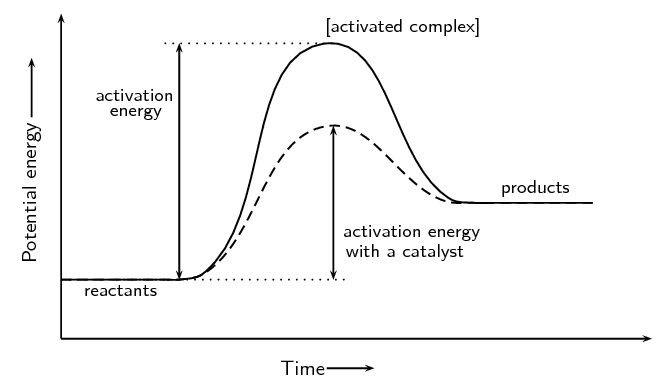
How can I represent an endothermic reaction in a potential energy diagram?
Answer
545.4k+ views
Hint: The potential energy diagram represents the change in the potential energy of the system when the reactant compound undergoes chemical reaction to form a product. In an endothermic reaction, the heat is absorbed by the system. The potential energy graph is drawn between potential energy and time.
Complete step by step answer:
The endothermic reaction is defined as the reaction where heat is absorbed. The energy changes that take place during the chemical reaction is shown by a diagram which is known as a potential energy diagram.
The potential energy diagram shows the change in the potential energy of the system when the reactant compound changes to produce.
For the endothermic reaction the enthalpy change $(\Delta H)$ is positive and for exothermic reaction the enthalpy change is negative. In the endothermic reaction, the total potential energy of the system increases as the energy is absorbed by the system. For the exothermic reaction, the total energy of the system decreases as the energy is released by the system.
The potential energy diagram for endothermic reaction is shown below.

In the potential energy diagram of endothermic reaction, the potential energy of the reactant should be lower than the product. The hump is higher than the beginning which shows the system gains energy during the chemical reaction which is the activation energy complex. The reacting particles must have enough energy to overcome the barrier.
Note:
In endothermic reaction, the enthalpy change should be greater than zero $\Delta H > 0$ and for exothermic reaction the enthalpy change should be lesser than zero $\Delta H < 0$.
Complete step by step answer:
The endothermic reaction is defined as the reaction where heat is absorbed. The energy changes that take place during the chemical reaction is shown by a diagram which is known as a potential energy diagram.
The potential energy diagram shows the change in the potential energy of the system when the reactant compound changes to produce.
For the endothermic reaction the enthalpy change $(\Delta H)$ is positive and for exothermic reaction the enthalpy change is negative. In the endothermic reaction, the total potential energy of the system increases as the energy is absorbed by the system. For the exothermic reaction, the total energy of the system decreases as the energy is released by the system.
The potential energy diagram for endothermic reaction is shown below.

In the potential energy diagram of endothermic reaction, the potential energy of the reactant should be lower than the product. The hump is higher than the beginning which shows the system gains energy during the chemical reaction which is the activation energy complex. The reacting particles must have enough energy to overcome the barrier.
Note:
In endothermic reaction, the enthalpy change should be greater than zero $\Delta H > 0$ and for exothermic reaction the enthalpy change should be lesser than zero $\Delta H < 0$.
Recently Updated Pages
Why are manures considered better than fertilizers class 11 biology CBSE

Find the coordinates of the midpoint of the line segment class 11 maths CBSE

Distinguish between static friction limiting friction class 11 physics CBSE

The Chairman of the constituent Assembly was A Jawaharlal class 11 social science CBSE

The first National Commission on Labour NCL submitted class 11 social science CBSE

Number of all subshell of n + l 7 is A 4 B 5 C 6 D class 11 chemistry CBSE

Trending doubts
Differentiate between an exothermic and an endothermic class 11 chemistry CBSE

10 examples of friction in our daily life

One Metric ton is equal to kg A 10000 B 1000 C 100 class 11 physics CBSE

Difference Between Prokaryotic Cells and Eukaryotic Cells

1 Quintal is equal to a 110 kg b 10 kg c 100kg d 1000 class 11 physics CBSE

State the laws of reflection of light




